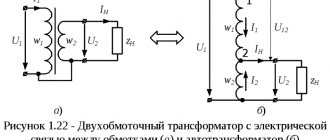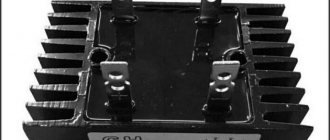In household and industrial work related to electrical networks, various technical devices and devices are used. A voltage indicator (VI) helps a technician determine the presence or absence of current on live parts, and in everyday life when checking the serviceability of wiring and identifying damage in electrical installations.
UVN above 1000 V (left) and ULV up to 1000 V (right)
Purpose of the device
A voltage indicator is especially in demand before connecting grounding and upcoming electrical work, since working with a de-energized line will save the life and health of the technician. The absence of voltage in the electrical circuit will allow you to begin the safe repair of the emergency section of the network, installations, sockets, sockets, switches and lamps.
The peculiarity of the device is that it is small in size and portable, and its weight and design features facilitate the use of the device by one person. Portable pointer models have batteries or rechargeable batteries. If the device is used frequently, the batteries need to be changed and the battery charged.
A high-quality UN is supplied with a passport, operating instructions and a case. The device can be single-pole, double-pole, non-polar, above 1 kV and universal. Touching the pole to any element that conducts electricity indicates the presence or absence of voltage.
Domestic and imported models of the device are made in accordance with GOST - 20493-2001 ; 20493-90 ; 15150-69 and TU 34-28-17004-78 .
IMPORTANT! When working with UN, it is advisable to wear rubber work gloves. This safety rule must be observed in all cases of interaction with electrical networks.
Design
Pointers are classified into different types, but the design for them is identical, and consists of:
- compact handle;
- insulating body part;
- working surface (housing, signal lamp, capacitor);
- conductor.
The indicator body is reliably protected from dust and moisture, and is made of electrical insulating material with a surface roughness of at least class 3 according to GOST 2789-73. Depending on what type of sign it is, it will have additional design details.
If single-pole devices have only one housing, then double-pole devices have two at once. The housings of a two-pole UN are connected to each other with a flexible wire up to 100 cm, with an insulating thickening at the entrance (shock-absorbing bushing). There are also sound and light indicators.
IMPORTANT! Testing using UN is carried out between all phases and the zero indicator.
The ideal indicator for a trader
The question arises, if the EMA is already working at its limit and shows the most relevant price changes, then why do traders not use the EMA all the time? The fact is that for EMA it does not matter at all how long the trend being studied is. Any more or less significant price surge radically changes the direction of the forecast, which can be very misleading and lead to losses.
It turns out that traders do not need to have indicators with low lag - we need some balance between short reaction time and filtering out false emissions. The most famous of these developments is the adaptive moving average - AMA. There are also quite a lot of variations.
Principle of operation
Before starting operation, make sure that the indicator is in good condition and there is no external damage. The principle of operation of the device is to receive a signal in the form of a sound or a light bulb when the electrodes touch the electrical circuit.
Single-pole, pen-shaped pointers touch part of the network, checking for the presence of alternating current only. To do this, take the device by the handle in your right hand and touch the desired part of the network with the probe. In this process, grounding will be done through the human body (this is not dangerous and does not affect his health), through the touch of the thumb of the right hand to the metal contact, and the light bulb begins to glow. If there is no glow, it means there is “0” in the circuit or a complete absence of current.
Also read: Purpose of silica gel in transformers
The operation of bipolar devices is based on the principle of electrodes touching two phases of an electrical installation. The two-pole VV is suitable for AC and DC mains testing. When checking, a neon lamp with a power of no more than 10 W should light up. Each device has a limiter in the form of a shunt resistor - this helps limit the current.
IMPORTANT! It is easy to use any type of pointer, the main thing is to follow safety rules. Both types of indicators apply to devices up to 1000 V.
Terms of use
Before you start using the device, it is important to inspect it each time for damage and quality of insulation, and then make sure that the indicator is working. You need to touch the phase, knowing that it is energized. If the device is faulty, an error will occur, causing injury or short circuit. When using the indicator, it is important to be attentive and careful and strictly follow the following rules:
- The indicator must comply with the parameters of the electrical network. It is quite simple to verify this; you just need to read the markings located on the device body.
- One effective and easy-to-implement way to avoid unwanted contact is to keep your free hand in your pocket, otherwise there is a risk of creating a closed circuit for an electrical discharge.
- When checking functionality, you must take a stable position, eliminating the possibility of falling or accidentally touching grounded conductors.
To minimize the likelihood of accidents, you must strictly follow all the rules and requirements for performing work, as well as use personal protective equipment. When using single-pole devices, do not use dielectric gloves. There must be contact between the specialist’s finger and the plate located on the indicator handle for the purpose of grounding. If difficulties arise when performing work, it is better to contact experienced electricians who will reduce wasted time and save your health. You can find a specialist in the distribution network, energy supply company or housing office; they will provide all the necessary information.
Classification
Each UN has a different cost, since according to its quality characteristics it belongs to a certain technical group. The group is determined based on qualities and tests, as indicated in a special protocol attached to the device. The following groups are distinguished:
- Based on indicators:
- up to 1,000 V;
- above 1,000 V.
- By number of poles:
- single-pole - single-pole devices have a gas-discharge indicator lamp, an additional resistor, 2 electrodes - in the form of a tip and a manual contact. At the lower end of the body there is a metal probe for touching the network.;
- bipolar - the bipolar also has lugs (2 pcs.), up to 7 mm in length; when checking the voltage, one contact is connected to one phase of the electrical installation, and the second to the other, carrying current in the circuit, the signal light will light up: with alternating - 2 lamps, and with constant – with the index “+” or “–” (according to polarity).;
- Universal:
- alternating current;
- at constant current.
- According to the indicator:
- neon;
- LED;
- acoustic;
- digital.
- Contactless.
A single-pole indicator can be purchased from 205 rubles to 2200 rubles. A two-pole UN costs from 170 rubles to 2700 rubles. Universal signs are sold from 615 rubles, and contactless signs – from 690.
Single-pole voltage voltages are easy to use, resemble a screwdriver or a pen in appearance, and are suitable for ratings up to 1000 V, used for installations with alternating current. The disadvantage of the device can be considered the inability to check the network with direct current. Such devices include, for example, INO-70, UNN-90.
A two-pole UN has 2 component dielectric parts and a copper conductor-connector. The device is suitable for testing AC and DC networks. To do this, touch two parts of the installation. The device is produced by manufacturers in the form of various compact models. The LED scale shows values up to 1000 V. For example, UNN “Kombi” uses LEDs as an indicator. In this case, the power source is a capacitor with a large capacity. Such a UN also gives a sound signal. The most popular two-pole device is also Pin 90M.
All indicators above 1000 V are considered high voltage and monitor alternating current indicators when touching a phase. This device does not have contact pads and is used for large electrical installations. For example, a portable UVN is intended for testing installations with a voltage of 35 kV.
Also read: Purpose of dielectric gloves in electrical installations
Universal pointers are used to control zero and phase. The indicators for them are LEDs, and the voltage source is a high-capacity capacitor. Such devices are indispensable for electricians and production workers, as they allow you to check the connections of different electrical circuits in the absence of a power source.
When applied to a wall, a non-contact UN perceives an electromagnetic alternating field. It makes it easy to determine the voltage without touching exposed parts of the electrical network. The device has sound and light indicators. Digital devices have an LCD with values that are displayed on the screen.
IMPORTANT! There are also UN that determines low voltage (PIN-90), its values cannot be more than 50-90 V.
DIY LED voltage indicator
Checking the voltage in the circuit is a procedure necessary when performing various types of work related to electricity. Some amateur electricians, and sometimes professionals, use a homemade “control” for this - a socket with a light bulb to which wires are connected.
Although this method is prohibited by the “Rules for the Safe Operation of Consumer Electrical Installations,” it is quite effective when used correctly. But still, for these purposes it is better to use LED identifiers - probes. You can buy them in a store, or you can make them yourself.
What is a logic probe used for?
This device is successfully used when it is necessary to perform a preliminary check of the operability of the elements of a simple electrical circuit, as well as for the initial diagnosis of simple devices - that is, in cases where high measurement accuracy is not required. Using a logic probe you can:
- Determine the presence of a voltage of 12 - 400 V in the electrical circuit.
- Determine the poles in a DC circuit.
- Check the condition of transistors, diodes and other electrical elements.
- Determine the phase conductor in the AC electrical circuit.
- Ring the electrical circuit to check its integrity.
The simplest and most reliable devices with which the above manipulations are performed are an indicator screwdriver and a sonic screwdriver.
Electrician's probe: principle of operation and manufacture
A simple identifier with two LEDs and a neon light bulb, which has received the name “arcashka” among electricians, despite its simple device, allows you to effectively determine the presence of a phase, resistance in an electrical circuit, and also detect a short circuit (short circuit) in the circuit. The universal electrician's tester is mainly used for:
- Diagnostics for broken coils and relays.
- Continuity checks of motors and chokes.
- Checking rectifier diodes.
- Definitions of terminals on transformers with multiple windings.
This is not a complete list of tasks that can be solved using a probe. But the above is enough to understand how useful this device is in the work of an electrician.
A regular battery with a voltage of 9 V is used as a power source for this device. When the tester probes are closed, the current consumption does not exceed 110 mA. If the probes are open, then the device does not consume electricity, so it does not need either a diagnostic mode switch or a power switch.
The probe is capable of performing its full functions until the voltage at the power supply drops below 4 V. After this, it can be used as a voltage indicator in circuits.
During the continuity of electrical circuits, the resistance of which is 0 - 150 Ohms, two light-emitting diodes light up - yellow and red. If the resistance value is 151 Ohm - 50 kOhm, then only the yellow diode lights up. When a network voltage of 220 V to 380 V is applied to the probes of the device, the neon lamp begins to glow, and at the same time a slight flickering of the LED elements is observed.
The diagram of this voltage indicator is available on the Internet, as well as in specialized literature. When making such a probe with your own hands, its elements are installed inside the housing, which is made of insulating material.
Often, for these purposes, the housing from the charger of any mobile phone or tablet computer is used. A probe pin should be removed from the front part of the case, and a high-quality insulated cable, the end of which is equipped with a probe or an alligator clip, should be removed from the end part.
Assembling a simple voltage tester with an LED indicator is shown in the following video:
How to make an electrician's tester with your own hands?
Some thrifty hobbyists can find many useful things in their “arsenal,” including an earphone (capsule) for the TK-67-NT telephone.
Another similar device, equipped with a metal membrane, inside which there is a pair of series-connected coils, is also suitable.
Based on such a part, a simple sound probe can be assembled.
First of all, you need to disassemble the telephone capsule and disconnect the coils from each other. This is necessary in order to free their conclusions. The elements are placed in the earphone under the sound membrane, near the coils. After assembling the electrical circuit, we will receive a completely working identifier with sound indication, which can be used, for example, to check the tracks of printed circuits for mutual bridging.
The base of such a probe is an electric generator with an inductive opposite relationship, the main parts of which are a telephone and a low-power transistor (preferably germanium). If you do not have such a transistor, then you can use another one with NPN conductivity, but in this case the polarity of the power supply should be changed. If you cannot turn on the generator, the terminals of one (any) coil must be swapped with each other.
You can increase the sound volume by choosing the frequency of the electric generator so that it is as close as possible to the resonant frequency of the earphone. To do this, the membrane and the core must be placed at an appropriate distance, changing the interval between them until the desired result is obtained.
How to choose the right one
The choice of UN should be based on the area of use - for household or permanent industrial needs. In everyday life, single-pole indicators are used. In production, it is better to use a two-pole device, as it shows more accurate voltage figures and is high-voltage.
When choosing a device, you need to pay attention to the following points:
- Percentage of reading error. Should not be more than 3%.
- Response speed. Normally 70 – 300 samples/s.
- Electrical safety class. Depends on the future purpose of the circuit: local, distribution or low voltage.
- Fire safety level. Must be equipped with overload protection function and shut off automatically.
It is better to purchase a high-quality device in specialized lighting stores that are ready to provide a certificate and passport for the product, which indicates the serial numbers of each component and attaches a diagram. A high-quality device is marked on the case, the date of manufacture, and an indication of the rated current. Many UNIs are equipped with probes or current clamps, which allow measurements to be taken without violating the insulation of the conductors.
IMPORTANT! The device must have a warranty not only from the manufacturer, but also from the seller. It is preferable to purchase a product from a domestic or European manufacturer (Germany, Denmark, Sweden).
Price of indicator screwdrivers from well-known manufacturers
As for the cost of voltage indicators, devices should be divided into three categories.
Simple options. These are screwdrivers that have a blade, a body, a neon lamp and a resistor. The price for such products ranges from 20 to 40 rubles. Despite their long service life, manufacturers provide a one-year warranty on such devices. The likelihood of mechanical damage to the plastic case probably plays a role.
Multimeters are the most expensive
Screwdrivers with additional functions. The ability to test and determine a break under the plaster provides for a more complex design. Consequently, the price of indicator screwdrivers of this type will be higher. The minimum cost is 45–50 rubles, the maximum reaches 200 rubles. Among this type of device, those models with the ability to adjust the sensitivity level have a high price.
Multimeters. They are distinguished by the highest cost, since they are a combination of three devices in one device: an ammeter (current measurement), a voltmeter (voltage measurement) and an ohmmeter (resistance measurement). The price of such testers varies from 2500 to 5000 rubles.
Many domestic and foreign companies are engaged in the production of indicator screwdrivers. According to users, the most reliable and durable products are considered to be JTC, EXPERT, JONNESWAY. The above price range is focused on devices from these manufacturers.
Requirements for pointers
The general list of requirements for the use of UN includes compliance with the stated technical characteristics according to GOST, verification, which includes visual inspection, resistance to mechanical and climatic influences, electrical insulation resistance, accurate operation of the charger, compliance with working drawings, presence of roughness, complete set of all components (especially the restrictive ring), the presence of a certificate and accompanying documents (diagrams, instructions, memos, etc.).
Visual inspection consists of inspecting and checking serviceability, completeness, integrity of packaging, presence of markings and corrosion protection. Compliance with the working drawing is carried out using measuring tools. The surface is checked for the presence of roughness using an optical indicator or profilometer. If the product body is made of metal, then it must be made in accordance with GOST 9.302.
Also read: What is a surge suppressor (SPD)
The unit must be in good working order, without external damage, with working light and sound signals, and the insulating parts must have dielectric properties. The current value must be indicated in the technical data sheet. Only if such requirements are met is the device permitted to be used.
IMPORTANT! All UN have a production test report and a safety certificate issued by the authorized bodies of the Russian Federation. The tested device has a tag with a stamp with the verification date.
Why does the indicator light up when you touch the neutral wire?
I have been asked this question many times. One of the reasons is the incorrect use of the LED indicator. How to properly hold the LED probe indicator when searching for a phase is written in the article above.
The second possible reason for this behavior of the indicator is a break in the neutral wire. For example, a circuit breaker installed after the meter on the neutral wire tripped. In old apartments this is not uncommon and is a gross violation of the electrical wiring. It is imperative to remove the machine from the neutral wire or short-circuit its terminals with a jumper.
When the neutral wire breaks, a phase is supplied to it through devices connected to the electrical network, for example, through a switch backlight indicator, a TV in standby mode, any charger, a computer turned off only by the start button and other electrical appliances. The indicator shows this. In this case, the neutral wire can be dangerous and touching it is unacceptable. It is necessary to find and repair a break in the neutral wire, which may also be located in junction boxes.
Check before use
Before using the UN, it is inspected for the presence of external mechanical damage and operability - the appearance of a light or sound signal. To do this, the pointer probes are briefly brought closer to any electrical network parts.
Before checking, it is forbidden to ground the device, as it does not need it. Grounding needs to be done only in the only case when it is intended to work on wooden supports when installing a power line in the air. Here, check the voltage before working with secondary circuits, identifying phase wires, etc. carried out within 5-7 s.
In specialized laboratories, circuits are collected from which the insulation and indication value are determined. Here, indicators are also measured when they gradually increase from zero to working value, within 60 s.
IMPORTANT! To test the device, the requirements of GOST 12.3.019 , which must be carried out at a temperature of (25 ± 10) ° C (according to GOST 15150 ).
Necessary materials for making an indicator
To make a simple LED device that indicates phase or voltage (approximately), you need to find a working circuit. Then buy or obtain the following parts and tools:
- LED of any type;
- a diode opening with a current of 10-100 mA at a forward potential of 1 V, with a breakdown voltage (reverse) of at least 30-75 V;
- resistor 100-200 kOhm;
- bipolar transistors;
- soldering iron;
- wires;
- metal plate (can be cut from a beer can);
- plastic case, preferably transparent;
- sting, you can take a regular nail.
Chinese soldering iron with USB charging.










